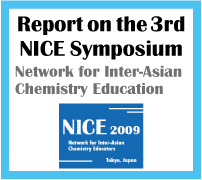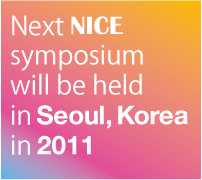PROGRAM
 First day: Wednesday, July 29
First day: Wednesday, July 29
9:30-9:40O
- pening ceremony
9:40-10:40
- Plenary lectures
- Training in Teaching Science and Approach to Problems in Science Education
- Tadashi Hasegawa
- Tokyo Gakugei University
- BRINGING THE GAP BETWEEN RESEARCH AND PRACTICE IN SCIENCE LEARNING: A Model for Participatory Evaluation of a University-High School Collaborative Study in Taiwan
- Mei-Hung Chiu
- National Taiwan Normal University
10:40-11:402
- min talk (introduction of poster presentation)
11:40-13:00
- Lunch
13:00-15:00
- Demonstrations and Workshops, Poster presentations
1.Students' conceptions and conceptual change
1P1-1Reading comprehension of pupils on solar energy with various text formations: a focus on sustainability
- Shyan-Jer Lee*, Wan-Chen Wu and Lynn Farh
- Department of Applied Chemistry and Life Science,
- National Pingtung University of Education
1P1-2Examination and suggestion to General education on Natural Science Courses in higher education
- Chin-Cheng Chou
- The General Education Center, HUNGKUANG University
1P1-3 Does the students’ conceptual development have a parallel relation with the scientific development? ---Take the conception of gas particle as an example
- Chun-Keng Liu*, Mei-Hung Chiu, & Chun-Wen Lai
- National Taiwan Normal University, Graduate Institute of Science Education
2. Instructional strategies, Use of audio-visual instruments in classes
1P2-1An analysis of multiple choice items from science examinations for middle schoolers’ evaluation
- HyunJu Park1, JuRan Shin2
- 1Department of Science Education, Chosun University, 2Department of Science Education, Chosun University
1P2-2Exploring in-services teachers’ viewpoints about model and modeling processes via the perspective of methodology
- Jing-Wen Lin, Yu-Lun Wu
- Department of Natural Science, Taipei Municipal University of Education
1P2-3 Strategies for Improving Teaching and Learning of Chemical Equilibrium at the Secondary School Level
- Derek Cheung
- Department of Curriculum and Instruction, The Chinese University of Hong Kong
1P2-4 Development of a lesson model in chemistry through “Special Emphasis on Imagination leading to Creation” (SEIC)
- OGAWA Haruo1*, FUJII Hiroki2, and SUMIDA Manabu3
- 1 Department of Chemistry, Faculty of Education, Tokyo Gakugei University, 2 Faculty of Human Culture and Science, Prefectural University of Hiroshima, 3 Faculty of Education, Ehime University,
1D2-1 Real Image of Electron Clouds in Glass Blocks – A Profitable Tool for the Understanding of Atomic Orbitals –
- Nakako Tokita, Sumio Tokita
- Studio Nebula
1D2-2 Calculation of potential energy in the reaction of “I + H2 → HI + H” and its visualization
- Hiroshi Nagashima, Akira Ikuo*, Yusuke Yoshinaga, and Haruo Ogawa
- Department of Chemistry, Tokyo Gakugei University
1W2-1 Transformable 3D models for teaching-learning the chirality due to a tetrahedral stereogenic center or a chirality axis.
- Rosa Elena Arroyo-Carmona1, Aaron Perez-Benitez2
- 1 Departamento de Ciencias de la Salud. Universidad Popular Autonoma del Estado de Puebla. 2 Facultad de Ciencias Quimicas. Benemerita Universidad Autonoma de Puebla.
3. Chemistry in daily life, Attitude toward chemistry
1P3-1 What ditermines the color of flamber flames?
- Hiroto Ashikaga
- Tottori Technical High School
1P3-2 CHEMISTRY IN THE CLASSROOM: LEARNING THROUGH AMUSING EXPERIMENTS
- Miguel Peris
- Dept. of Chemistry. Universidad Politécnica de Valencia
1P3-3 The Basic Science-Related Interdisciplinary Study Program of University Students in Taiwan
- Kuo-liang Wu and Mei-Hung Chiu
- National Taiwan Normal University
1P3-4 DESCRIBING ELEMENTS, COMPOUNDS AND TERMINOLOGY AMONG THREE COUNTRIES
- Choon Ho Do
- Department of Polymer Sci. & Eng., Sunchon National University
1P3-5 Chemical Literacy and Learning Sources of Non-Science Major Undergraduates on Understandings of Environmental Issues
- Show-Yu, Lin
- Department of Natural Sciences, School of General Education, Aletheia University
1P3-6 Canceled
1D3-1 A Hand-made Molecular Model for the Basic Organic Chemistry
- Kazumi Yamaguchi, Yasuaki Sasamura
- Tomakomai National College of Technology
1W3-1 Science craft of making name plates using chemical etching
- Risa Sonoda, Asuka Tsuda, Masahiro Kamata
- Department of Science Education, Tokyo Gakugei University
4. Lab activities
1P4-1 A Computer Aided Learning System for the Manipulation of Electric Machinery Experiment
- Huan-Wen Tzeng1
- 1Department of Industrial Education, National Taiwan Normal University
1P4-2 A Study of Chemistry Experiment Design and Assessment
in the Chemistry Course at Elementary Level
- Wen-Tung Hung1 Chin-Hsiang Fang2
- 1Meiho Institute of Technology, 2Tajen University
1P4-3 Thermochemical Approaches to Neutralization Reactions between Weak Acid and Strong Base
- Saki Mishima, Satoshi Maeta, Tomoyuki Tatsuoka, Nobuyoshi Koga*, Yoshihiro Furukawa
- Department of Science Education, Graduate School of Education, Hiroshima University
1P4-4 Development of Chemistry Experiments for Materials Science and Engineering Majors
- Jui-Lin She*, Yeun-Min Tsai
- Department of Chemistry, National Taiwan University
1P4-5 Chemistry Laboratory as Scientific Inquiry in Japanese Lower Secondary Science Classes
- Akira Saito, Tomomi Kosaka
- Department of Chemistry, Tokyo Gakugei University
1P4-6 Development of experimental program for acquisition of equilibrium concept: from a standpoint of energy concept
- Akira Ikuo*, Maki Ichikawa, Yusuke Yoshinaga, and Haruo Ogawa
- Department of Chemistry, Tokyo Gakugei University
1P4-7 Strategies for Assessing Chemistry Students’ Inquiry Skills
- CHAN, Chi-keung
- Law Ting Pong Secondary School
1P4-8 Senior high school students’ understanding of measurement in chemistry experiment
- Sung-Lin Feng1, Hsiao-Lin Tuan2
- 1National Dali Senior High School, 2 Graduate Institute of Science Education, National Changhua University of Education
1D4-1 The presentation of the experiments in chemistry class in Japan and the comparison of the curricula
- Eiji Iwatoh1, Yuko Morimoto2
- 1 Tokyo Gakugei Univ. Senior High School, 2 Tokyo Gakugei Univ. International Secondary School
1D4-2 Electrolysis with coin-shaped Li-MnO2 battery as a student experiment
- Shigeki Hiramatsu 1
- 1KEIO Shonan Fujisawa Jr. & Sr. High School
1W4-1 Educational Experiment Using Natural Radioactivity
- Mariko Nakamura1, Masahiro Kamata2
- 1Faculty of Engineering, Tottori University, 2Department of Science Education, Tokyo Gakugei University
15:00-15:30
- Coffee break
15:30-16:30
- Free time
18:00-20:00
- Banquet: Palace Hotel TACHIKAWA
 Second day: Thursday, July 30
Second day: Thursday, July 30
9:40-10:40
- Plenary lectures
- The Effect of Affective Characteristics on Student’s Acheivement in Scientific Literacy: A Comparative Case Study of PISA Data
- Ji Young Kim 1,2, and Hee K. Chae2
- 1Myoungil Middle School, 2Department of Chemistry Education, Seoul National University
- High School Chemistry Grand Prix: Past, Present, and Future*
- Yoshitaka Minai
- Nedzu Chemical Laboratory and Center for Arts and Sciences, Musashi University
10:40-11:402
- min talk (introduction of poster presentation)
11:40-12:40
- Lunch
12:40-14:40
- Demonstrations and Workshops, Poster presentations
2.Instructional strategies, Use of audio-visual instruments in classes
2P2-1 Analyzing teachers’ instructional explanation to improve chemistry teaching
- liang Liao
- Department of curriculum and instruction, The Chinese University of Hong Kong
2P2-2A Lesson Model Fostering Fine Ideas in Chemistry Concerning Bio-diesel on the Basis of "Education for Sustainable Development": Potentialities for Collaboration with Social Study
- Atsushi Hiramatsu1*, Kenji Takabayashi2, Ryoichi Utsumi1, Hiroki Fujii3, and Haruo Ogawa4
- 1Hiroshima University High School, 2Hiroshima Prefectural Itsukaichi High School, 3Faculty of Human and Culture and Science, Prefectural University of Hiroshima, 4Department of Chemistry, Tokyo Gakugei University
2P2-3Promotion of Student's Abilities in Proper Judgement on the Topic of Bio-energy: Development of Lesson Model in Chemical Education
- FUJII Hiroki1*, OGAWA Haruo2, UTSUMI Ryoichi3, and HIRAMATSU Atsushi3
- 1Faculty of Human Culture and Science, Prefectural University of Hiroshima,2Department of Chemistry, Faculty of Education, Tokyo Gakugei University, 3High School attached to Hiroshima University
2P2-4 Using Science Video clips in High school Chemistry I class
- Hwa Young Jyun1, Jin Young Uh2
- 1Chung Dam High School, 2Ogum High School
2P2-5Modelling and Cognitive Apprenticeship into Teaching and Research of the Senior Secondary Curriculum with New Technology
- Tsai Ping-kun1, Chiu Mei-Hung2, Tsai Che Ming1*, Chang Yueh-Ju1, Jhao Song Ye1
- 1Jianguo High School, 2Graduate Institute of Science Education, National Taiwan Normal University (NTNU)
2P2-6Comparison Study of Secondary Chemistry Curricula of Chinese-Taipei, Japan and Korea
- N. Seunghyeon Gim and Hee K. Chae
- Department of Chemistry Education, Seoul National University
2D2-1Observation of NaCl crystallization process from its aqueous solution droplet on a glass slide using a computer and the video camera mounted on a microscope under controlled experimental conditions: Effects of humidity and surface area of the droplet on the crystallization process.
- Satoshi Taguchi, Sato Hisanori
- Department of Chemistry, Sapporo Campus, Hokkaido University of Education
2D2-2 Teaching Chemistry Using Multi-representational Models
- Shiao-Lan Chung1, 2 Mei-Hung Chiu1*
- National Taiwan Normal University, Taiwan1
- National San-Chung Senior High School2
2W2-1Inexpensive and easy-to-assemble model for illustrating octahedral coordination compounds containing polydentate ligands.
- Aaron Perez-Ortiz,1 Aaron Perez-Benitez,1,* Enrique González-Vergara,2 Miguel Angel Mendez-Rojas.3
- 1Facultad de Ciencias Quimicas. Benemerita Universidad Autonoma de Puebla. 2Centro de Química del Instituto de Ciencias. Benemerita Universidad Autonoma de Puebla. 3Departamento de Ciencias Químico-Biológicas, Universidad de las Américas-Puebla
3. Chemistry in daily life, Attitude toward chemistry
2P3-1 T.E.S ‘A Visit of Inspection for studying Science’ with Special Themes
- Min-woo Kim, Jieun Lee
- Deokhyeon middle school
2P3-2 Science Classes Utilizing a Sudoku Puzzle
- Je Jeong Ryu1, Soo-ah Lee2
- 1 Dongducheon Sincheon Elementary School, 2 Sinmook elementary school
2P3-3Taiwan Technical College Students’ Learning Interesting about General Chemistry and Living Chemistry
- Hsin-Chung Ting
- Childhood Education & Nursery, Chia Nan University of Pharmacy & Science
2P3-4Korean Students’ Understanding of Chemistry through Posters and Pictorial Poems
- Meehwa Choi
- Yeouido High School
2P3-5The effect of the creative problem solving in life-science classes on students’ creative behaviors
- Hsiu-Yin Lin, Yu-Ling Lu, Chi-Jui Lien
- Department of Science Education, National Taipei University of Education
2D3-1Using Block Models to Enhance Student’s Understanding of Chemical Equations
- Izumi Imai1, Wataru Tainaka2, Hachiro Ueno3
- 1 Komaba Toho Junior-Senior High School, 2,3 NHK Educational Corporation
2W3-1 Science craft of making name plates using chemical etching
- Risa Sonoda, Asuka Tsuda, Masahiro Kamata
- Department of Science Education, Tokyo Gakugei University
4. Lab activities
2P4-1 Organic Chemistry Laboratory for Undergraduate Students
- Junki Higo, Yasushi Ito, Yukari Nagai, Yuko Sawahata, Takayuki Nakamura, Yutaka Maeda, Nobutoshi Yoshihara, and Tadashi Hasegawa*
- Department of Chemistry, Tokyo Gakugei University
2P4-2The Experiment of mini pottery making in the high School Class of Chemistry
- Natsuko Kanzaki
- Faculty of Science and Engineering, Waseda University
2P4-3 Clear and easy experiments to show chemical behavior of carbon
- Takuya Miyauch
- Setagaya Junior High School attached to Tokyo Gakugei University
2P4-4 Educational experiment to confirm hydrolysis of sucrose in sugar candy
- Eiichi Ueno
- Morimura High School
2P4-5How Thick is the Laminated Aluminum Foil of Flexible Food Packages and How Many Atomic Layers are There? Students’ Quantitative Problem Solving through Complexometric Titration Experiments
- Shui-Ping Yang* and Chung-Chia Li
- Department of Chemistry, National Changhua University of Education
2P4-6Development of Teaching Materials for Chemistry and NT Session of ASTORE Program
- Wonghil Chang1, Byoung Joon Ahn2
- 1Department of Basic Medical Science, Jeonju University, 2Division of Science Education, Chonbuk National University
2P4-7 Small and Cute Silver Tree
- Hwa Jung Kim
- Hankwang Middle School
2D4-1A Convenient Measurement of Oxygen Concentration using Zinc Air Battery
- Yuu Tanaka and Nobuyoshi Koga*
- Department of Science Education, Graduate School of Education, Hiroshima University
2D4-2Phenolphthalein as Organic Teaching Materials: Small-scale Preparation and Modeling for Some Functional Dyes
- Kiichi Amimoto* and Nobuyoshi Koga
- Department of Science Education, Graduate School of Education, Hiroshima University
2D4-3Development of chemical experiment that doesn't need consumption of reagents
- Masahiro Kamata, Yumi Nakamura
- Department of Science Education, Tokyo Gakugei University
2W4-1 My Melody – Simple chemical cell
- Seok Cheon Jeon
- Soonhmoon High School
2W4-2Hands-on experience of a periscope-type DVD spectroscope: an inexpensive and high-resolution simple spectroscope
- Fumitaka Wakabayashi
- Department of Science and Engineering, National Museum of Nature and Science
5. Representation of textbooks, Sharing/exhibiting of products of science fair
2E5-1Erroneous Descriptions for Colligative Properties in Korean High School Chemistry Textbook.
- Nak Han Jang
- Department of Chemistry Education, Kongju National University
2E5-2 An Indigenous School’s Participation in Science Fairs in Taiwan
- Fu, Li-Yu
- Center for Teacher Education, National Tsing Hua University
14:40-15:00
- Coffee break
15:00-17:00
- Mini-symposium on Chemistry Olympiad
Introduction of Korean Chemistry Olympiad
Guncheol Kim
Department of Chemistry, Chungnam National University
Panel discussion
Closing ceremony



